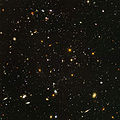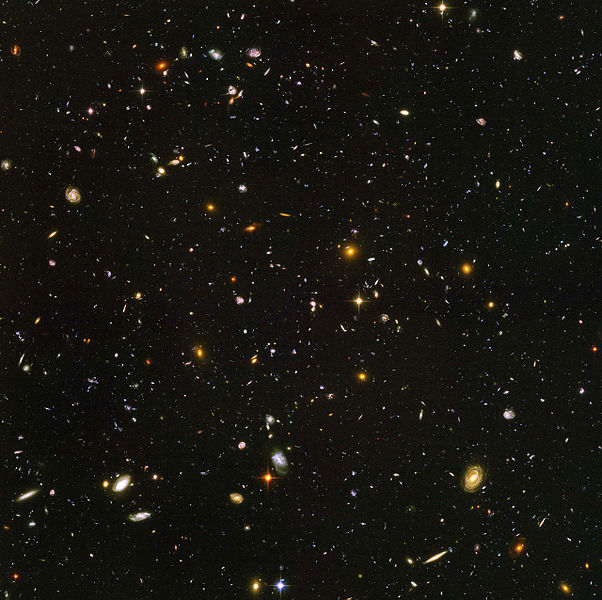
|
This image was uploaded to the shared "Image Pool" and is usable on any CreationWiki site.
Please go to the Pool to edit its description.
|
Summary
Galaxies, galaxies everywhere - as far as NASA's Hubble Space Telescope can see. This view of nearly 10,000 galaxies is the deepest portrait of the visible universe ever achieved by humankind.Called the Hubble Ultra Deep Field, this galaxy-studded view represents a "deep" core sample of the universe, cutting across billions of light-years.
The snapshot includes galaxies of various ages, sizes, shapes, and colors. The smallest, reddest galaxies, about 100, may be among the most distant known, existing when the universe was just 800 million years old. The nearest galaxies - the larger, brighter, well-defined spirals and ellipticals - thrived about 1 billion years ago, when the cosmos was 13 billion years old.
In vibrant contrast to the rich harvest of classic spiral and elliptical galaxies, there is a zoo of oddball galaxies littering the field. Some look like toothpicks; others like links on a bracelet. A few appear to be interacting. These oddball galaxies chronicle a period when the universe was younger and more chaotic. Order and structure were just beginning to emerge.
The Ultra Deep Field represents a narrow, deep view of the cosmos, like looking through an eight-foot-long soda straw.
Copyright status:
This image is under Creative Commons license because it comes from NASA, a government-run association
Source:
http://www.nasa.gov/multimedia/imagegallery/image_feature_142.html
File history
Click on a date/time to view the file as it appeared at that time.
| Date/Time | Thumbnail | Dimensions | User | Comment |
|---|
| current | 06:23, 20 April 2011 |  | 1,280 × 1,275 (274 KB) | Wiedman | Galaxies, galaxies everywhere - as far as NASA's Hubble Space Telescope can see. This view of nearly 10,000 galaxies is the deepest portrait of the visible universe ever achieved by humankind.Called the Hubble Ultra Deep Field, this galaxy-studded view re |
File usage
The following page uses this file:

